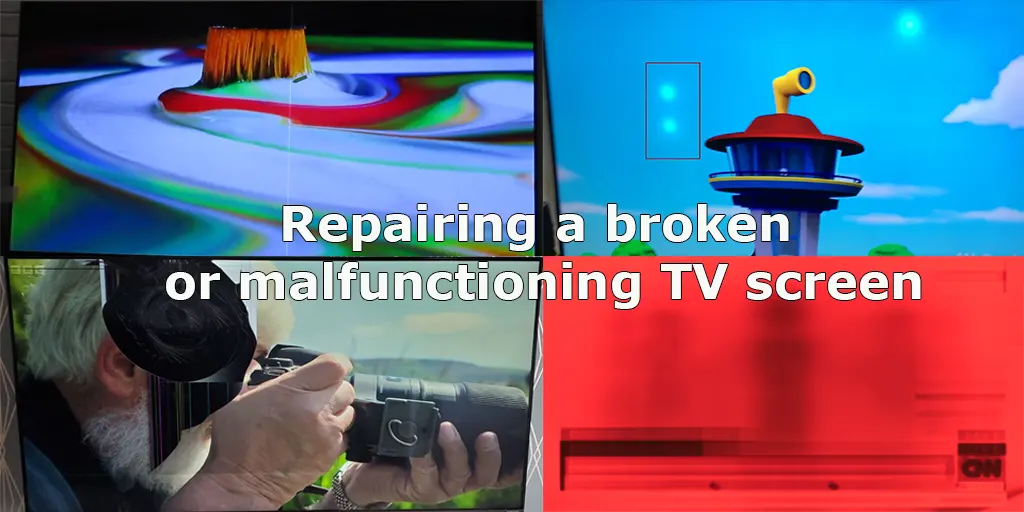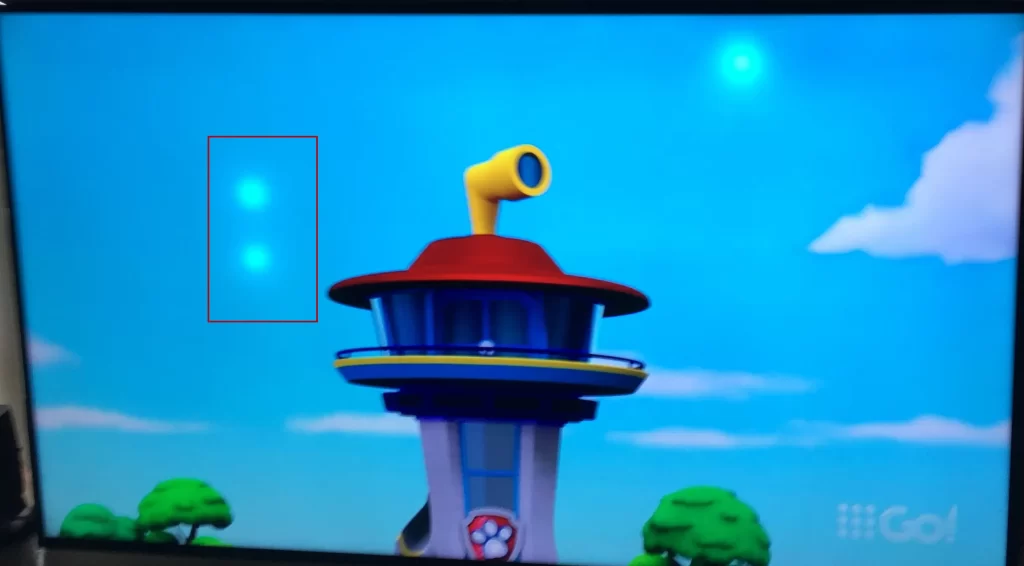If you have a big, modern TV and it suddenly breaks, the worst thing that can happen to it is a broken or black screen. The TV may stop showing the picture, it may have streaks, or your TV screen may crack. And, of course, you have a legitimate question – which is easier – to call a specialist or buy a new TV. I will tell you how to diagnose your TV and what to do in each case.
Let me tell you right away: if the screen of your TV is broken and it has no warranty or protection plan, then repairing such a TV is impractical; the repair is expensive and protracted. The display is 80% of the value of the TV. It will be easier for you to dispose of the TV. To save money, you can sell the internal components, the power board, and the main board, so you get back part of the value of the TV.
What types of televisions are available (picture technology)
- CRT (cathode ray tube): This is the granddaddy of all televisions; everyone born before 2000 knows these televisions. The CRT TV is big, heavy, and bulky. These TVs are obsolete and are no longer manufactured.
- Plasma: Plasma TVs replaced CRTs as TVs with larger screen sizes and superior picture quality. In them, an electrical charge is applied to tiny cells filled with a mixture of inert gases, causing them to emit ultraviolet light. This light then hits the phosphors, forming an image. Such TVs are also obsolete and are no longer manufactured, as of 2014, to be exact.
- LCD (Liquid Crystal Display): This technology emerged as a smaller and more energy-efficient alternative to plasma. Unlike plasma, LCD panels are thin and lightweight, making them easy to mount on walls or place on stands. In an LCD TV, liquid crystals are placed between two layers of glass. These crystals adjust by letting light pass through them and thus form an image.
- LED (light emitting diode): LED TVs are a variation of LCD TVs but with a different type of backlight. Instead of fluorescent backlighting, LED TVs use light-emitting diodes.
- OLED (organic light emitting diodes): In an OLED screen, each pixel emits its light, i.e., it can be switched on and off individually. This results in highly accurate color reproduction and crisp blacks. In addition, OLED screens are fragile and lightweight. But the screen is also based on a thin layer of glass.
What causes damage to the TV screen?
- Physical impact on the TV screen: One of the most common causes of TV screen damage is physical impact. Whether it’s a flying video game controller, a child’s toy, or even accidental contact while moving the TV, the display can crack.
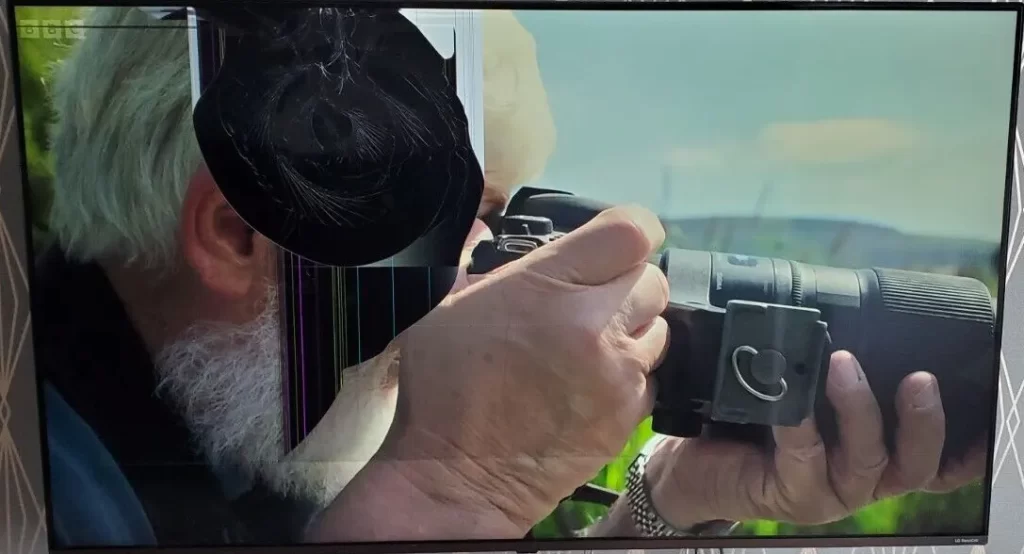
- Burn-in: This primarily affects OLED and older plasma TVs. Burn-in occurs when a static image is left on the screen for an extended period, resulting in a ghostly mark on the display forever. This can be anything from logos and TV channel tickers to paused video game graphics.
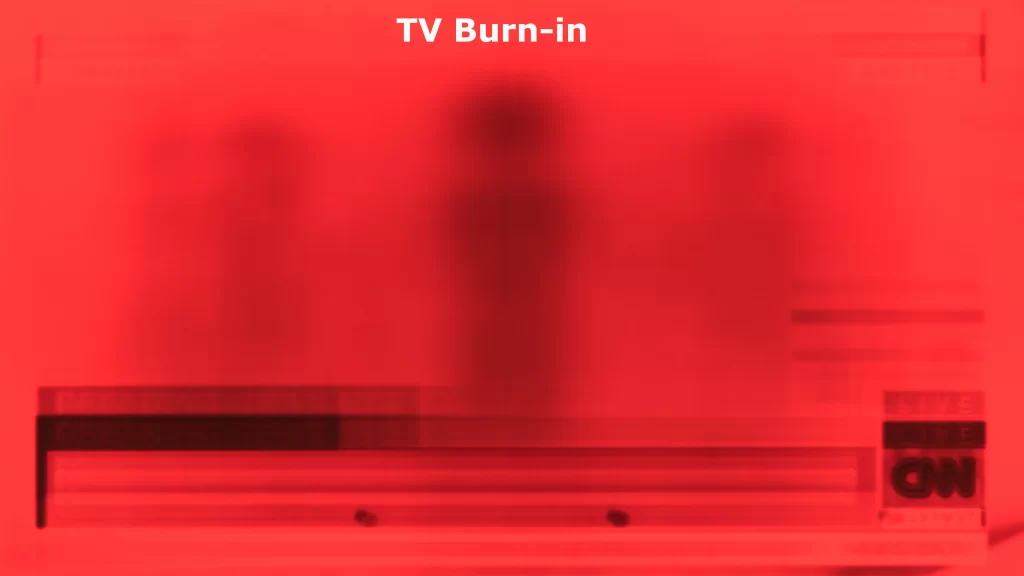
- Overheating: All electronic devices generate heat, and TVs are no exception. If a TV is not properly ventilated or is located near a heat source such as a radiator, it can overheat. High temperatures can damage the glass, which is the backbone of LED and OLED screens, and it can crack.
- Electrical problems: Any LED or OLED screen has a control board that controls the screen; it can break. Also, LED TVs have a backlight, which can break, especially in cheap TVs.
- Humidity and dampness: Exposure to moisture can also damage the TV screen; TV displays are not designed to operate in high humidity. Of course, there are TVs designed to work outdoors; they have extra protection.
- Improper cleaning of the screen: Despite seemingly harmless, using the wrong cleaning products for your TV screen can lead to problems. Alcohol or ammonia-based cleaners can destroy the protective coating on many screens, leading to clouding or discoloration over time.
How do I know if my TV screen is broken?
In order to determine whether it is worth repairing your TV, you need to diagnose it and find out what exactly is not working. In fact, there can be about a hundred variants of malfunctions. Some malfunctions may be typical and appear on many TVs, such as a backlight malfunction. Other faults can be very individual and difficult to fix.
How to identify physical damage to the TV screen
The most obvious sign of a broken TV screen is that there is sound but no picture. This means that the TV’s main board and power supply are working, but the screen, alas, is faulty. Next, check the TV screen for visible damage. Cracks, glass shards, or spider web-like patterns indicate physical damage. If you notice any of these signs, the screen is undoubtedly broken and unusable.
- If you have an LED TV and lines, appear on it: If unusual colors or lines appear on your TV screen that won’t disappear, this could be another sign of screen damage. Vertical or horizontal lines indicate a display malfunction, usually when the pixel control circuitry is broken. Such a malfunction is not curable; such a TV can be watched, but the lines will be annoying.
- In an LED TV, part of the screen is darkened or has bright spots: This is a defect of the backlight; if part of the TV screen is dark, then one of the backlight lines is defective. And if you see bright spots on the screen, it is usually in TVs with direct backlight, dried up and fell off the scattering lens on the LED. If, in such a TV, the LED stops shining, the screen will appear in places with weak illumination dark spots. This TV has a very cheap screen; cheap is a synonym for poor quality. Even Samsung, in the budget series, has this problem. So I think that if the TV belongs to the budget series, the probability that the display is of low quality is very high.
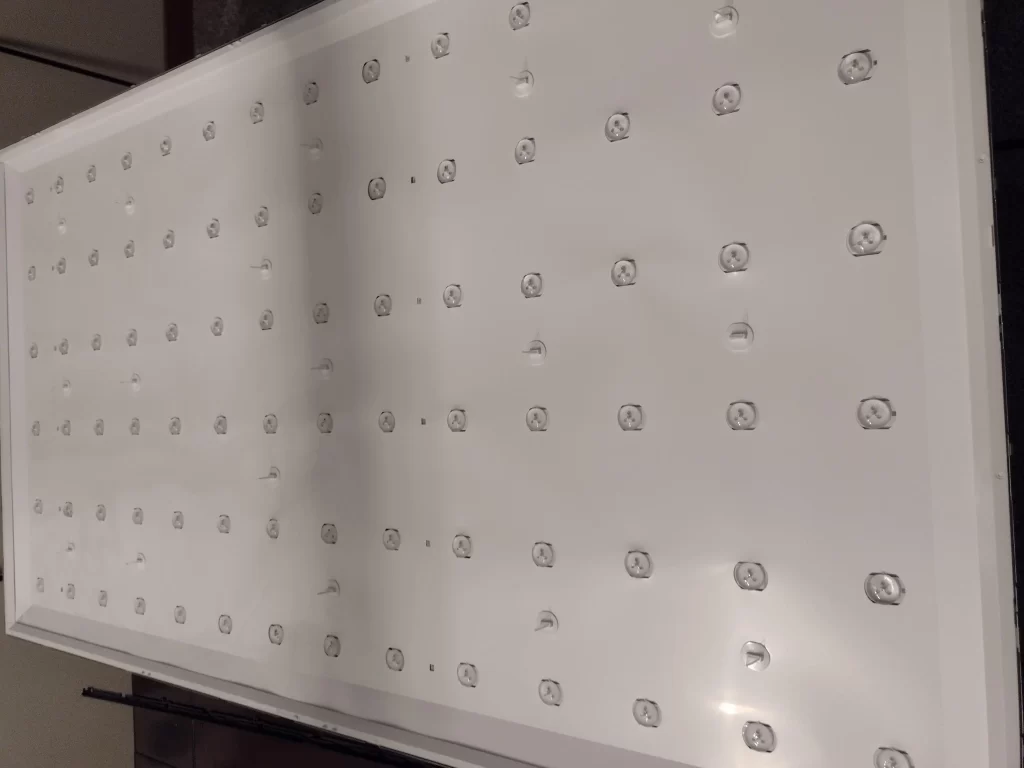
- The TV screen is dark: Black screen, everything is straightforward; check if the screen backlight works (LED TVs). Turn on the TV in the dark and look at the screen; if the screen is glowing, then the backlight is working. So there is a malfunction in the display control circuitry.
- LED TV screen flickering: Screen flickering may indicate a power supply failure or display malfunction. Further diagnostics are required. It is usually a power supply board malfunction.
- LED, OLED TVs, Dead pixels: Dead or stuck pixels can look like tiny dots on the screen, usually red, green, or blue, that do not change color. This is extremely rare in modern TVs, and yes, it is a screen malfunction and cannot be repaired.
- Distorted, floating, wavy, blurred image: If a distorted image appears on the TV screen, there are usually two possibilities:
- Display malfunction, most likely related to overheating. Try letting the TV cool down first and see if the problem appears immediately after turning it on or after some time.
- A problem with the digital stream processing algorithm could be the second cause: updating the TV software. This does not happen in Sony, Samsung, and LG TVs.
- Lack of picture and sound: The TV is defective and most likely it is a problem with the power supply unit or the main board. To diagnose the TV, you need to invite a specialist to diagnose the problem. When diagnosing, check whether the power supply unit is supplied with the necessary voltage. And whether the power supply is working.
What causes TV screen damage?
Statistically, most screen failures are due to mechanical damage: the screen is cracked. There are also cases when the screen does not work due to poor manufacturing quality. But you can’t prove anything here; it’s a problem with cheap TV sets. But in general, the screens of large TVs are pretty reliable. However, Samsung had issues with backlight failure and screen overheating in some Crystal series TVs in 2016-2017. For example, Hisense TVs from five years ago, according to consumer feedback, were characterized by a very fragile screen: very often, when unpacked, they found the screen covered with cracks.
How do you fix a broken TV screen?
You should know that a broken LED or OLED TV screen is not repairable. If you read that you can repair cracks, it is not valid. A shattered screen can only be replaced, but as I said before, that’s not feasible. But if you do decide to replace the TV screen, you will face a lot of problems.
How you can replace the TV screen
The main problem is that TV manufacturers do not sell screens as spare parts. Regional warehouses of service centers receive a certain number of screens for replacement. Therefore, if the TV is under warranty and your case falls under the warranty, you can bring the TV to the service center, where you will replace the screen. And this is only beneficial under warranty.
How much does it cost to replace the TV screen?
Now, let’s calculate the cost of the repair. Imagine you have a 75-inch Samsung model Q70B TV; how much money will you spend to repair it without a warranty?
It will take a $50 car to bring the TV to the service center.
It needs to be packed; it’s good if you have a box, but if you don’t, you’ll have to make up or buy packaging. 20$
The cost of the screen is about $700.
The cost of the replacement labor is about $350.
Shipping the TV to your home is $50.
So you’ll spend about $1,150 on repairs, and a new 2023 TV costs $1,200. Plus, you still have money; it’s a $50-$70 call to a specialist to diagnose the TV, and you’ll spend at least a month on the repair.
Can you fix a TV screen with lines?
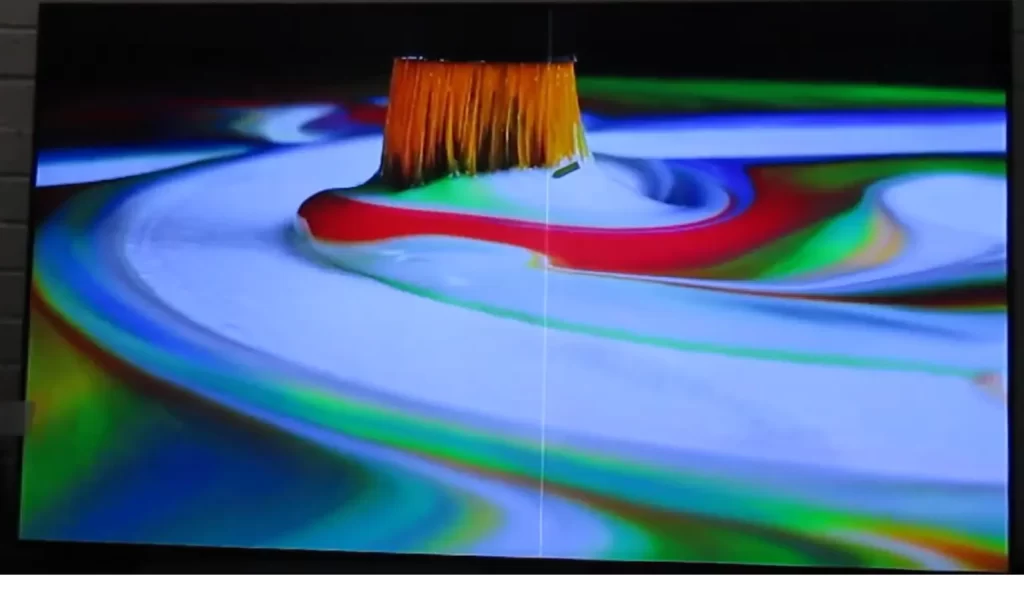
Lines on the TV screen are a fairly common problem with LED and OLED TVs. The lines can be vertical or horizontal. They occur when the vertical or horizontal scanning of pixels on the screen does not work correctly. In LED TVs, this causes the pixels to freeze or not open. In OLED TVs, the situation is similar, except that the pixels glow constantly or not at all.
This is mainly due to a malfunction of the display control board. In this case, the lines may be colored or white. Less often, the problem is in the display itself – a break in the control circuit, in which case the lines are black because the pixels are not working.
How to eliminate lines on the TV screen
- Disassemble the TV and check the loops from the control board to the display. You can wipe them with rubbing alcohol.
- Replace the display circuit board.
- There is one other option, but it usually doesn’t fix the problem, only minimizes it. And it only works if the lines are not one but many, and they are located in one place. If there are many lines in one place, one sampling line may be faulty, which affects the operation of neighboring lines. In this case, it is necessary to disconnect the contacts in the loop one by one, which can be done with the help of tape. This will disconnect the faulty line. If this can be done, only one circuit will be interrupted, and a small line will appear on the screen, while the others will operate normally.
Can LED TV panel be repaired?
If you have an LED panel, it can only be repaired if there is a backlight problem. Yes, in this case, you can disassemble the display and replace the backlight lines or LEDs. Find a professional who does this; it’s not an easy job. A large table is needed for the size of the TV screen; imagine if you have a 75-inch TV; how big does the table need to be to fit the entire TV? You need to know how to properly disassemble the display so you don’t damage the cables or break the TV. One person cannot handle such a large screen; you need helpers. You must buy the right backlight lines for an EDGE backlit TV or LEDs for a Direct backlit TV.
Can OLED TV panel be repaired?
OLED panel is not repairable, OLED panel is a very thin screen, it has no backlight. So if you have an OLED TV and the display is faulty, all you have to do is determine whether it’s the faulty control board or the display itself. If you’re lucky and it turns out that the control board is faulty, you can replace it, but if the display is faulty, you’ll have to replace the TV with a new one.


